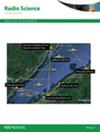2014年2月在中纬度观测到的20次太阳x射线耀斑VLF/LF振幅延迟与上升时间的相关性
IF 1.5
4区 地球科学
Q3 ASTRONOMY & ASTROPHYSICS
引用次数: 0
摘要
在白天,电离层中的电子浓度会被太阳耀斑放大,继而影响无线电波的传播。以往对甚低频信号的研究主要集中在x级和m级耀斑上。这项研究扩大了范围,包括更广泛的频率范围和c级耀斑。2014年2月20日至28日期间,英国巴斯的一台接收器记录了来自15个发射机(18.3-81.0 kHz)的信号。研究了在此期间捕获的20个太阳耀斑。采用了一种新的方法来确定接收振幅的上升时间,以便与地球静止运行环境卫星地球静止卫星记录的太阳x射线通量进行比较。计算了x射线通量开始与接收到的振幅变化开始之间的时间延迟。总的趋势表明,较短的延迟与较长的振幅上升时间呈线性相关。发现m级耀斑的延迟与上升时间线性相关的绝对斜率大于c级耀斑。两个耀斑显示了在x射线通量开始之前接收振幅的开始时间。一种可能的解释是,接收到的信号也可能受到硬x射线的影响,而不是被分析的软x射线。总之,本研究证明了c级和M级小耀斑对VLF/LF信号传播的影响,为进一步研究太阳耀斑对无线电波和下电离层的影响提供了见解。本文章由计算机程序翻译,如有差异,请以英文原文为准。
Correlation between the delay and rise time of VLF/LF amplitudes during 20 solar X-ray flares observed in February 2014 at mid-latitude
During daylight hours, the concentration of electrons in the ionosphere can be amplified by solar flares, which may subsequently influence the propagation of radio waves. Previous research on Very Low Frequency (VLF) signals focused on X-class and M-class flares. This study expands the scope to include a broader frequency range and C-class flares. During 20-28 February 2014, signals from 15 transmitters (18.3—81.0 kHz) were recorded by a receiver in Bath, UK. 20 solar flares captured during this period are investigated. A new methodology was employed to determine the rise times of the received amplitudes for comparison with the solar X-ray flux recorded by the Geostationary Operational Environmental Satellite geostationary satellite. The time delays between the onset of the X-ray flux and the onset of received amplitude changes are calculated. The general trend shows that shorter delays are linearly correlated to longer rise times of the amplitudes. It is found that the absolute slopes of the linear correlation between the delay and the rise time of M-class flares are larger than those of C-class flares. Two flares showed onset times of received amplitudes preceding the X-ray flux onset. A possible explanation for this is that the received signals might also be influenced by hard X-rays rather than the analyzed soft X-rays. In summary, this study demonstrates the effects of small C-class and M- class flares on the propagation of VLF/LF signals and offers insights for further research on solar flare impacts on radio waves and the lower ionosphere.
求助全文
通过发布文献求助,成功后即可免费获取论文全文。
去求助
来源期刊

Radio Science
工程技术-地球化学与地球物理
CiteScore
3.30
自引率
12.50%
发文量
112
审稿时长
1 months
期刊介绍:
Radio Science (RDS) publishes original scientific contributions on radio-frequency electromagnetic-propagation and its applications. Contributions covering measurement, modelling, prediction and forecasting techniques pertinent to fields and waves - including antennas, signals and systems, the terrestrial and space environment and radio propagation problems in radio astronomy - are welcome. Contributions may address propagation through, interaction with, and remote sensing of structures, geophysical media, plasmas, and materials, as well as the application of radio frequency electromagnetic techniques to remote sensing of the Earth and other bodies in the solar system.
 求助内容:
求助内容: 应助结果提醒方式:
应助结果提醒方式:


